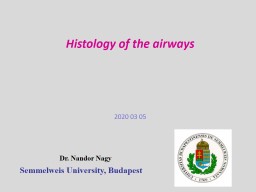

2020 03 05 Semmelweis University Budapest Dr Nandor Nagy Extrapulmonar Nasal cavity nasopharynx Larynx Trachea Intrapulmonar Bronchi principal lobar ID: 1034485
Download Presentation The PPT/PDF document "Histology of the airways" is the property of its rightful owner. Permission is granted to download and print the materials on this web site for personal, non-commercial use only, and to display it on your personal computer provided you do not modify the materials and that you retain all copyright notices contained in the materials. By downloading content from our website, you accept the terms of this agreement.
1. Histology of the airways2020 03 05Semmelweis University, BudapestDr. Nandor Nagy
2. Extrapulmonar:Nasal cavity - nasopharynxLarynxTracheaIntrapulmonar:Bronchi: principal lobar segmentalBronchioles: terminals respiratoryRepiratory part: alveoli
3. Olfactory regionReceptors: primary sensory cells: bipolar cells contain OBP (odorant binding protein) receptors on their plasma membrane. axon-like processes - fila olfactoria – bulbus olfactorius number of cells: 2 x 107 life time: 30-60 days more than 100 receptor moleculesciliabulb-like endingsupporting cellreceptorbasal cellsbasement membraneSchwann cellsciliaaxon
4. Histology of the larynx
5.
6. TracheaPrincipal bronchi
7. Trachea
8.
9. Bronchus treePrincipal bronchus lobal bronchussegmental bronchus terminal bronchus bronchiolus terminal bronchiolus bronchiolus respiratoricus sacculus: ductus alveolaris alveoli
10. Lung
11. Histological changes in the respiratory systemcartilage disappears: graduallyglands are disappearingsmooth muscle becomes continuous (broncioles) and then disappearsepithelium becomes thin
12. Branches of the terminal bronchi, sacculi and alveoliLobes : segmentsSegments:borders: veinsartery + bronchioles (centrally)
13. Epithelium: terminal bronchi
14.
15. Clara cells: new name is „club cells”!
16.
17.
18. Alveoli and alveolar septummacrophagealveolar entranceelastic fiberstype I cellstype II cellsmacrophage in the septumcapillary
19.
20. Type I. and II. pneumocytes, alveolar macrophages
21. Pneumocytes: simple squamous epithelial cellsType I cells: flat, squamous cells: gass exchangeType II cells: surfactant secretion: decreases the surface tension*Decreases the alveolar surface tension, actively participate in the clearance of foreign materials.*Low surface tension: increases the flexibility of the lung makes the alveoli stabile.*Absence of the surfactant: alveoli collapse
22. Respiratory distress syndrome (RDS) – functional surfactant disorder Fetal or neonatal RDS (IRDS): more frequent in premature infant 1.) unmatured biosynthetic pathways 2.) inactivation of the surfactant (intraalveolar coagulation) 3.) increased use of surfactant caused by chronic respiratory mechanism 4.) injury of the biosynthetic pathway (acidosis, decreased pulmonary blood flow) Adult RDS (ARDS): acut respiratory insufficiency activation of neutrophyl granulocytes and alveolar macrophages release of permeability increasing substances (shock, trauma:. burning, infections, inhalation of toxic gases, overdosage of drogss etc)
23. The effect ot the fetal surfactant